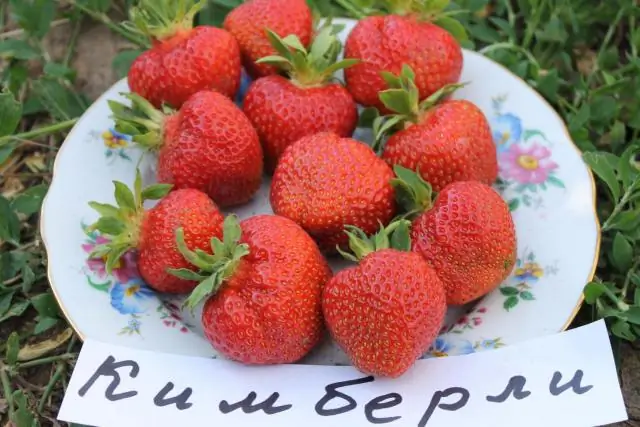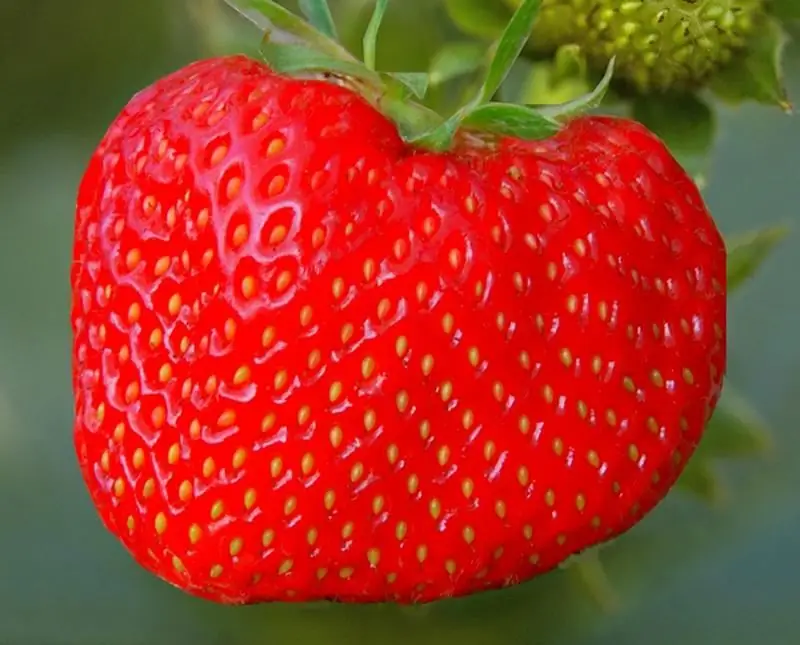
Table of contents:
- Author Bailey Albertson [email protected].
- Public 2023-12-17 12:53.
- Last modified 2025-06-01 07:32.
How to care for strawberries in spring for a good harvest

Strawberries are a very labor intensive crop. Some summer residents do not even plant it, fearing that there will not be enough time to leave. But it is impossible to imagine a plot without strawberries, especially if the family has children. To get a normal harvest, you need to start caring for the plantation in early spring.
Content
- 1 Clearing the beds from foliage and removing winter shelters
- 2 Feeding strawberries and watering
- 3 Protection against pests and diseases
- 4 Planting (transplanting) strawberries
- 5 Video: what to do with strawberries in spring
Clearing the beds from foliage and removing winter shelters
It is from the strawberry garden that most summer residents begin to inspect their possessions in the spring when they first come to the site. If there is no snow anymore, it is impossible to delay the cleaning of the plantation, every day is expensive in this matter. Often the garden bed looks very dull: there are more dry and diseased leaves on it in spring than green ones. But these dry leaves often contain various pests or pathogens. Therefore, everything that has not survived the winter should be removed as soon as possible.
However, in many regions, strawberries are wrapped for the winter with modern nonwoven materials such as spunbond. If the cover is still held by unfilled snow or ice, it is too early to remove it. Otherwise, the material is removed immediately, after which the cleaning of the plantation begins.
How to make cleaning easier is up to the owner himself. If the soil is already dry, it is better to start with the use of rare rakes: they will collect a significant proportion of the debris. But in an unsuccessful variant, you can pull out some good bushes with a rake. Therefore, you often have to work by hand on your knees, armed with a pruner. In addition to dry leaves, green leaves are also cut off, severely affected by spots. But if the winter is harsh and even there are few spotted leaves, it is better to leave them for now.

Often a strawberry plantation in early April is a miserable sight.
It is best to burn both the trimmed parts of the plants and the old mulch right away. If, during work, a strong infection of strawberries with a tick is noticed, immediately after cleaning it should be treated with insecticides without delay. Even a Chlorophos solution according to the instructions can help with this.
It happens that after the work done, not weak frosts return. Therefore, after cleaning the bed, keep nonwovens ready to cover the strawberries if necessary. But really, winter is unlikely to return, and overwintered leaves are not afraid of moderate frosts. Therefore, it is better to mulch the bed with suitable bulk materials: best of all - with coniferous needles, in a layer of 4-5 cm, but first, the strawberries should be fed.

Mulching is not only a process that allows you to preserve moisture and heat, on clean mulch and berries will be clean
Feeding strawberries and watering
After peeling the strawberries, you need to help recover from the winter. To do this, it must be fed with nitrogen fertilizers. You can use any saltpeter, and preferably urea, the dose is about 5 g of active ingredient per 1 m 2. Thus, a small handful of granular fertilizer is roughly taken per square meter. If it is completely dry, it is better to apply the fertilizer in liquid form, dissolving it in a large amount of water. Usually, top dressing is carried out so early that urea is easily drawn into the soil by melt water and rains.
Humus is rarely brought in in the spring, but if this has not been done since autumn, it is advisable to sprinkle it in the aisles and lightly cover it with a hoe. More often, phosphorus-potassium fertilizers are given to strawberries in the summer. In the spring, foliar feeding is useful, but we are not talking about April, but about the beginning of flowering. With the blooming of the first flowers, the strawberries are sprayed with weak solutions of complete mineral fertilizers, adding zinc salt to the solution (preferably sulfate, to a concentration of 0.01%). At the same time, the aisles can be watered with infusions of mullein or bird droppings.

Mineral fertilizers can be applied both dry and in solutions
Unfortunately, no matter how snowy the winter is, the melt water is short-lived. Loosening the bed sazu after cleaning for some time conserves moisture, but then watering is required, especially if it does not rain.
In our area, strawberries have to be watered as soon as possible. We just put the hose in the garden bed, and the water flows … But as soon as the berries began to sing - stop! We have to maneuver between "if only it does not dry up" and "if only it does not rot."
Before flowering, you can water both at the root and by sprinkling, if the water is not too cold, but after the flowers open - only at the root. If possible, it is worth equipping a drip irrigation system, delivering water directly to the roots. The strawberry itself signals the need for watering: its leaves strongly droop in the heat.
Protection from pests and diseases
Strawberries are inherently very vulnerable to disease and pest infestation. Unfortunately, even in summer cottages it is not always possible to do without "chemistry". Therefore, if the gardener is not an ardent opponent of plant protection products, after harvesting plant residues on the first day of work on the plantation, it is worth spraying it with 3% Bordeaux liquid, which reliably protects against a complex of fungal diseases.

Apparently, Bordeaux liquid will remain in the gardener's arsenal for a long time.
When flower buds appear, but before the flowers bloom, strawberries are treated from a complex of pests: at this time, you can take any preparations of colloidal sulfur and good old Chlorophos. If harmful insects attack during flowering, copper oxychloride can be applied.
Opponents of "chemistry" often make do with relatively safe means. Thus, in the early spring can pour bushes with water of 60-65 on C (strictly, the thermometer), it destroys most of the larvae of pests. Many are also destroyed by the treatment of the plantation with ammonia solution. As soon as new leaves begin to grow, 40 ml of 10% ammonia solution is dissolved in a bucket of water and the strawberries are sprayed. If the soil is spilled, many pathogens of fungal diseases are destroyed. In addition to ammonia, many gardeners use iodine, hydrogen peroxide or potassium permanganate for prevention. Combined solutions are often prepared, for example, 1 g of permanganate and boric acid per bucket of water.
Planting (transplanting) strawberries
Strawberries can grow in one place for many years, but after 3-4 years their yield drops sharply, and there is no point in leaving them in place. In many regions, it is in the spring that new plantations are laid. As a rule, in April this is done in the southern regions. In the same month, if necessary, adult bushes are also transplanted to a new place. There are many options for planting strawberries; in summer cottages, it is usually planted in rows, leaving 50-70 cm between them, and in rows, depending on the variety, from 15 to 40 cm.

The busiest summer residents prefer carpet cultivation of strawberries
Unfortunately, in spring it is not so easy to find good planting material on your site. Until fresh leaves appear, time passes, and it is advisable to finish planting by about May 10. The garden bed should be ready long before the procedure. When preparing it, a large amount of fertilizer is applied since autumn. The best of these is well-rotted manure. For 1 m 2 they take two buckets, adding a little and mineral. Wood ash is also good in this matter.
Shortly before planting, the garden bed is spilled with a 0.1% solution of copper sulfate, strawberries are planted in cloudy weather. Seedlings are disinfected by immersion for 10 minutes in water at a temperature of about 45 ° C. When planting, the roots are straightened, and when filling them with soil, the most important condition is observed: the heart must remain slightly above the surface of the earth. The planted bushes are well watered, and in case of dry weather, subsequent watering has to be done very often until the strawberries continue to grow in a new place.
Video: what to do with strawberries in spring
Strawberries take a lot of effort throughout the season and springtime is very important for a good harvest. This is not to say that its cultivation is very difficult, but the work on the plantation is varied, they are extremely necessary.
Recommended:
A Variety Of Garden Strawberries (or Strawberries) Kimberly - Description, Care And Other Features + Photo

Information on planting and breeding of Kimberley strawberries (strawberries), care, planting, harvesting. Description of the variety. Reviews of gardeners about Kimberly strawberries
Chamora Turusi Variety Of Garden Strawberries - Features, Care And Other Important Aspects, The Difference Between Strawberries And Garden Strawberries + Photo

Everything about the Chamora Turusi strawberry variety: from planting and care to picking berries. Productivity, terms of fruiting, reviews of gardeners
All About Garden Strawberries (strawberries) Varieties Asia - Description, Planting, Care And Other Nuances + Photo

Description of the variety of garden strawberry Asia. Differences between strawberries and strawberries. Planting, care, reproduction. Protection against diseases and parasites. Reviews. Video. Photo
Garden Strawberries Albion: Description Of The Variety, How It Differs From Strawberries, Planting And Care, Reviews And Photos

Strawberry (garden strawberry) Albion: features, advantages, disadvantages. What do you need to know to get a rich harvest? Reproduction methods
Everything About Garden Strawberries (strawberries) Queen Elizabeth: Description Of The Strawberry Variety, Planting, Care And Other Aspects + Photo

Description of the variety of remontant strawberries Queen Elizabeth, often called strawberries: pros and cons, features of fruiting, planting, care, photos and reviews
